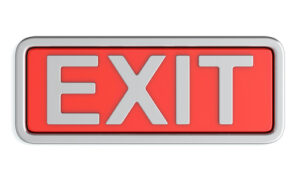All business owners are goal oriented. From the day you founded or assumed control of your company, you set targets and achieved them. That is why you are successful. You know how to define a goal and make it happen.
If I asked you to tell me the best thing that you did in the business three years ago, you’d likely respond with, “I have no idea.” or “Why would I know that?” or “Who cares?” You are busy looking forward.
 I’ve even had some owners get angry. They feel some obligation to know the answer, and that they are somehow failing a test if they don’t. The fact is, no entrepreneur has ever been able to give me a cogent answer about his or her accomplishments in the past.
I’ve even had some owners get angry. They feel some obligation to know the answer, and that they are somehow failing a test if they don’t. The fact is, no entrepreneur has ever been able to give me a cogent answer about his or her accomplishments in the past.
If I ask, “What do you plan to do in the coming year?” you will share plans to increase sales, hire new employees, or enter into a new area of business. Whether or not you have a formal strategic planning process, you have a pretty good idea of the changes and improvements you want to implement in the future.
Looking Past the Rearview Mirrors
An entrepreneur’s vision of “What’s next?” is frequently the most neglected aspect of their exit planning. They may term their goals for exiting in measurable, concrete terms. “I want to retire in five years with ten million dollars in the bank,” is an archetypical example. Others will couch their vision in terms of people. “I want financial security for my family, and continuing employment for my staff.”
All too often, their vision for the future deemphasizes or completely neglects their own individual needs. When pressed to enunciate more personal goals, they’ll often respond with something like, “I guess I’ll just play a lot of golf.”
Playing a lot of golf isn’t a retirement plan.
In a recent survey from PwC, they reported that 75% of business owners have regrets a year after they leave the business. The Exit Planning Institute did a survey ten years ago with the same result. According to Riley Moines, author of The Ten Lessons: How You Too Can Squeeze All The “Juice” Out of Retirement, six months to a year is the typical initial “vacation” period when a retiree catches up on travel and recreational activities.
After that first year, the reason so many ex-owners are unhappy is because they didn’t have a clear vision for their life after the business. Their expectations simply did not take into account the reality of what would happen when they were no longer spending the majority of their time working.
Leaping into the Void
When I ask about their plans for next year, some owners are more specific than others. But none of them ever say, “I don’t know. We may make money, or we may lose money. We may grow, or we may shrink. Whatever happens, happens. It doesn’t matter.”
Why would anyone expect that an entrepreneur who has driven towards goals for their whole life will suddenly be happy without purpose, without identity, and without a plan? It isn’t surprising that so many owners are reluctant to discuss exit planning at all. Life without the daily challenges and decisions that come with running a business seems unattractive. Their vision of the future is unclear.
The success of an exit strategy depends less on the amount of money your transfer generates than it does on your personal satisfaction. Unless you can identify a vision for a “next act” that is more appealing than what you are doing now, business ownership will never be in your rearview mirrors.
John F. Dini develops transition and succession strategies that allow business owners to exit their companies on their own schedule, with the proceeds they seek and complete control over the process. He takes a coaching approach to client engagements, focusing on helping owners of companies with $1M to $250M in revenue achieve both their desired lifestyles and legacies.




 Every time an employee asks, “What should I do about this, boss?” there is a little rush. It’s like an old cartoon. The good angel is sitting on one shoulder saying “Make them go through the thought process themselves.” The little horned devil is on the other shoulder saying “Go ahead. Tell him just this once. It’s faster, and it feels good.”
Every time an employee asks, “What should I do about this, boss?” there is a little rush. It’s like an old cartoon. The good angel is sitting on one shoulder saying “Make them go through the thought process themselves.” The little horned devil is on the other shoulder saying “Go ahead. Tell him just this once. It’s faster, and it feels good.”